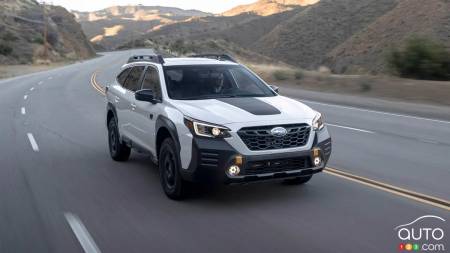This summer, we give you a 6-part review of the all-new Wilderness variant of the 2022 Subaru Outback. Today, part five, in which we wonder who’s actually in charge of this thing.
See also: 2022 Subaru Outback Wilderness Long-Term Review, Part 1: A Wild Idea That Wasn't Actually So Nuts
See also: 2022 Subaru Outback Wilderness Long-Term Review, Part 2: The Wilderness Beneath the Badging
See also: 2022 Subaru Outback Wilderness Long-Term Review, Part 4: Hey I know! Let’s go out into the woods!
All modern vehicles are loaded with driving aid features. The Outback Wilderness is no exception. Even with its mandate to go off-road as often as possible, it is also designed to be driven – safely – on the road.
At the heart of the electronic dome of safety is Subaru’s EyeSight suite of systems. Keeping in mind the Japanese automaker’s wont to do things differently than everyone else, its system uses cameras mounted behind the rearview mirror rather than embedded in the bumpers. The big advantage: the bionic eyes are less likely to go blind from dirt, slush and whatnot.
The Wilderness variant (like the Premier XT) also has an additional front camera with near-180-degree vision to detect sneaky obstacles.
Browse cars for sale available near you

Alert! Alert!
Once activated, EyeSight does essentially the same things as systems found elsewhere in the trade, so for instance, it keeps the vehicle in the centre of its lane by ‘reading’ the lane markers on the pavement (when visible); applies emergency braking if it detects any kind of object (vehicle, cyclist, camel, etc.) that could cause a boo-boo; warns the driver of the possibility of a collision; and, if the vehicle is not in the centre of the lane, warns the driver of that danger.
In short, all these gestures executed by artificial intelligence are meant to increase safety as well as reduce stress and inconvenience.
EyeSight does all of this, and even a little more than you might want. The system loves to multiply sound and visual alerts. I’m clumsy enough to ride briefly over a lane marker? Beep! I back up to within a country mile of a lamp-post? Beep!
When I engage the intelligent cruise control, the semi-autonomous driving system and I do not share the same definition of the apex of the curve, so the car pulls to the right while I prefer the left.
My passenger is slow to fasten their seatbelt? The Wild emits a chime of a volume and insistence that’s nigh on unbearable. Think toddler wanting for another cookie.
Three people to whom I lent the wheel for a few moments had the same reaction, summed up roughly thusly: “Yikes! Maybe this thing could actually let me drive instead of beeping all the time!?”

Overtaking the Swedes
For ages, Volvo has presented itself as the champion of road safety. Methinks maybe Subaru is out for that crown! The manufacturer is certainly putting a lot of effort into mishap-prevention measures. But this effort needs to be refined, in my humble opinion.
The lack of refinement is best exemplified by the system that stops the engine at a red light. The intention is laudable: to reduce fuel consuption and emissions by momentarily shutting down the engine. But when the Wilderness’ Boxer engine comes back to life, it does so with a twitch and a grunt. The transition could be smoother. This kind of frustrating, slightly rough-around-the-edges execution is commonplace in many of the Outback Wilderness' driving aids.
On the other hand, it's easy to forgive the Wild for displaying less-than-delicate manners in comparison with a Lexus. After all, it was designed to tackle rough trails. You don't expect a lumberjack to wear a tutu.
Besides which, you should know that all these driving aids can be easily deactivated with a physical switch or a touch icon. A deactivation of EyeSight that Subaru recommends before entering a car wash, by the way...


